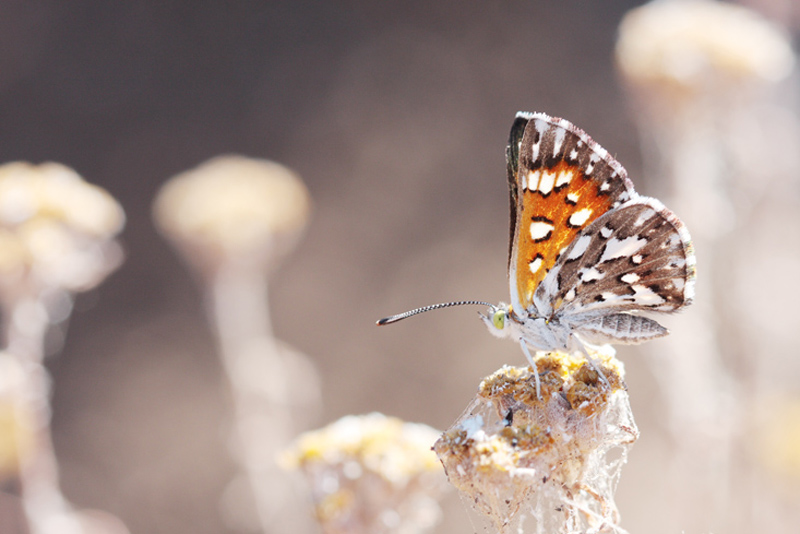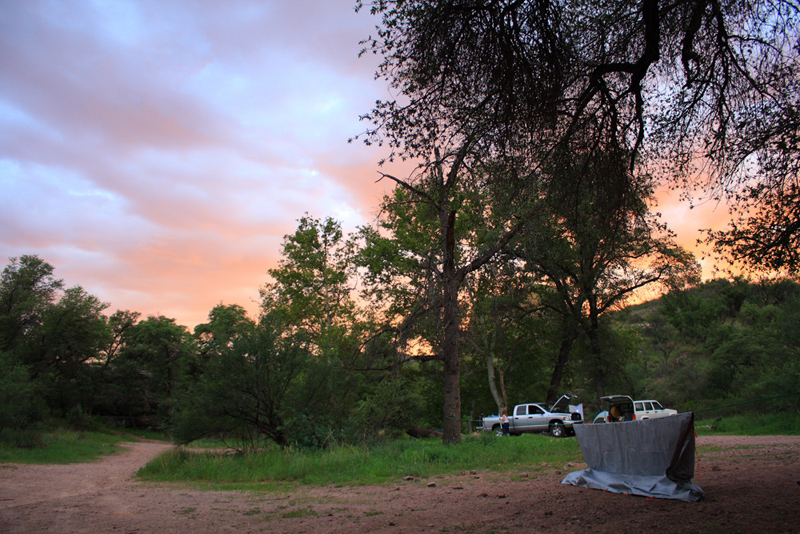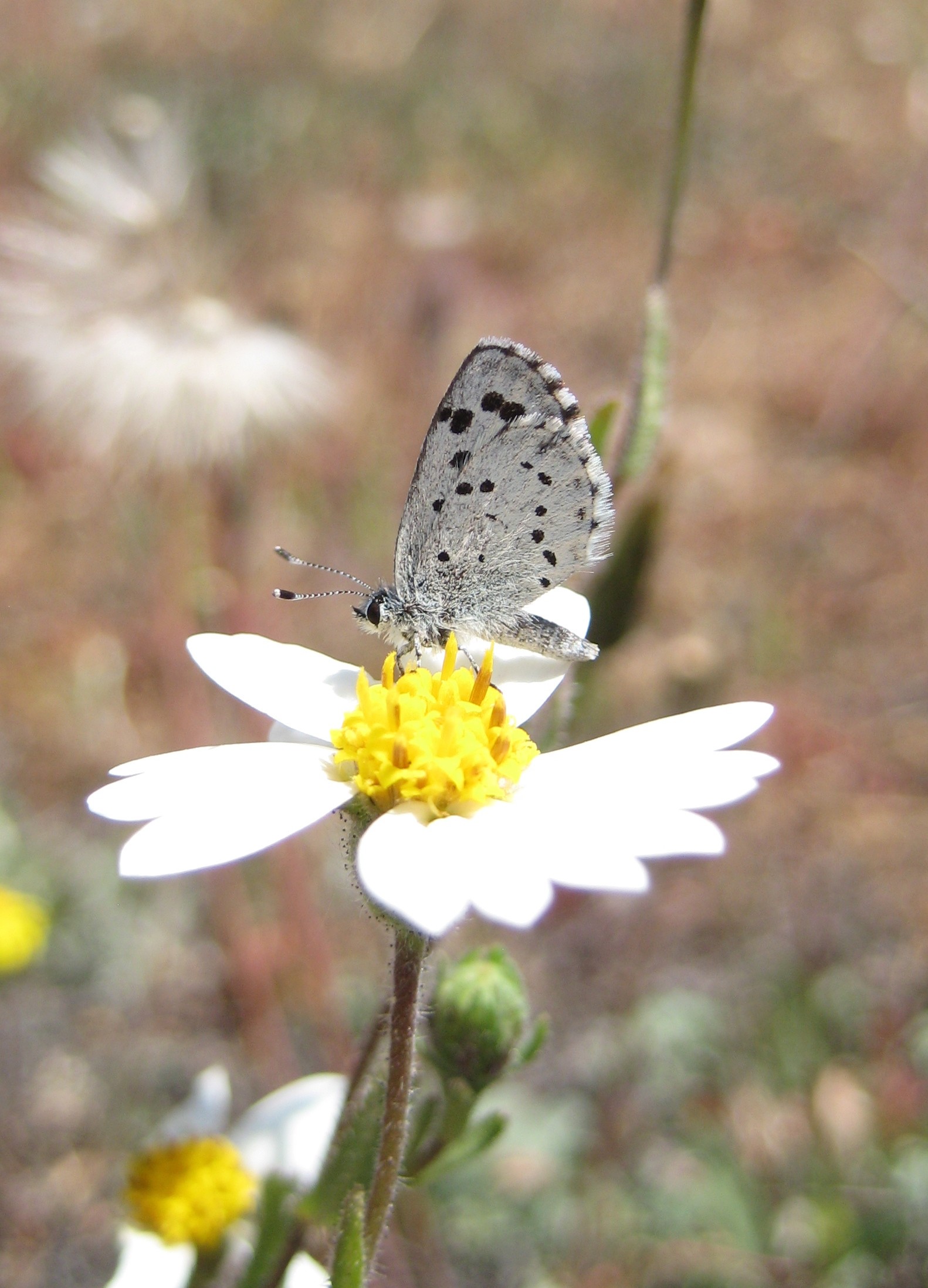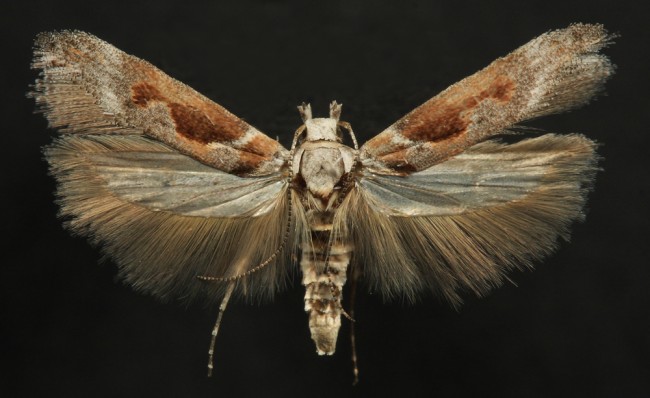Per Chris Grinter, on February 24th, 2010

Know this butterfly? It’s OK, no one really does. It is in the genus Apodemia (Riodinidae), but the taxonomy of this group is a disaster… and don’t even get me started on the subspecies. This specimen was photographed in September, meaning it is most likely to be Apodemia mormo (mormo) based on flight time. La. mormo is a fall flyer and La. virgulti is a spring flyer. While some forms seem distinctive, there is massive morphological overlap and they are usually identical and sympatric – actually down to living on the same plants. But according to lab experiments it is impossible to get the pupae to break diapause so they remain reproductively isolated. So are they different? While molecular work is being conducted the verdict is out, but it does seem like these two species may be retained in the end. I, per descomptat,, each mountain range has it’s own subspecies. Who knows, I sure don’t. I’m glad I don’t work on butterflies.
Species concepts are a fuzzy line and it’s never clear exactly where to make the cut. When asked what a species is most people default to the Mayr concept of Biological Species (BSC), where reproductive isolation = new. This is all well and good but we have to keep in mind that this is not the ONLY species concept. hi ha dozens, and not one is perfect. Groups like Grammia (Noctuidae: Arctiinae) exhibit high levels of hybridization, which does not adhere well to the BSC. I like to apply as many criteria as possible to delimit a species and it seems like the line is all too commonly thin within insects. I like to see a distinguishing morphological trait, if not in wing color or pattern, at the least in the genitalia or antennae. This is not always the case however and you have to look at the biology and/or DNA. I have looked at two insects that are for all intents and purposes identical. But the biology is radically different and a large % difference (over 8% – si, arbitrary) in their DNA makes it unquestionable that they are separate.
And if species weren’t contentious enough subspecies stir the pot even more. I’m skeptical about the entire concept, but there are cases in which it seems plausible and necessary. A subspecies is a more formal definition of a geographical “formulari” and usually exhibits a blend zone into another subspecies. For instance if you look at the 27 different populations of Plebejus icarioides there are large differences between northern and southern populations, but very subtile difference along the gradient. It is that persistent gradient that creates one dynamic species instead of 27 separate species – at least according to current research. Moths have been lucky and have thus far avoided the plague of over-subspeciation, butterflies not so much. There may even be instances where greedy collectors have named new subspecies of Parnassius for profit (new rare butterfly subspecies sell for big bucks).
The truth is that species concepts are artificial, poorly understood and dynamic at best; at worst it approaches a soft science with no real possibility of proof. Yet species are real and theories will continue to adapt while we sit here and scratch our heads.
Per Chris Grinter, el 23 de febrer, 2010 

One of the perks of being an entomologist is traveling and collecting. I put a few thousand miles on the car every summer and these are two of the best places in Arizona to collect. The top image is from the Baboquivari Mountains (Baboquivari Peak in the middle), Brown Canyon Research Station. The bottom image is of Pena Blanca Canyon, a famous collecting hotspot. This canyon is just 5 miles from Mexico and has a few safety concerns because of our current immigration policy. One morning, while sorting moths from the previous nights catch, a colleague and I had a group of roughly 30 illegals walk right through our camp. They were well dressed and clean, waved, and must have just been dropped off at the fence. Thankfully the majority of illegals are hard-working and honest people trying to earn a better life. It’s the coyotes and smugglers that are scarier – I have heard tales of Mexican police escorting drug caravans into the US with heavy artillery. And just last year a border patrol agent was stabbed to death by a coyote in this vicinity.
Per sort, a bunch of strange guys standing around strange lights at nights grants us a wide berth.
(Are these images small enough to load quickly?)
Per Chris Grinter, el 23 de febrer, 2010 Despite being pretty disinterested in butterflies, they are pretty to look at. Here is a really great video by a guy I know down in Southern CA. His time-lapse videos of lepidoptera life cycles are pretty impressive, and this one in particular is beautiful. If you cut to about 3:00 dins, you will see dozens of Great Purple Hairstreaks (Atlides halesus) emerging from their chrysalises, the colors are stunning. This butterfly is native to the SW and Mexico, and I have to admit I love finding it in the field.
[youtube=http://www.youtube.com/watch?v=KyWJlpIchkE]
Per Chris Grinter, el 23 de febrer, 2010 El breu comentari sobre Linus Pauling i la vitamina C per sota em va fer recordar el vídeo per primera vegada des de fa temps enrere per Pharyngula. Això és Kary Mullis, l'inventor de la PCR, i un guanyador del Premi Nobel. El seu invent anàlisi d'ADN bàsicament fet possible. Però igual que Pauling, ell també és completa i totalment les femelles. Si vostè té el temps per escoltar passeig, donar-li un tret. Però en curt, parla sobre l'astrologia, nega l'escalfament global i com la SIDA no és causat pel VIH. Em pregunto el que les estadístiques són per genis científics que llisquen fora del seu eix de balancí?
[Vimeo 9167379]
Per Chris Grinter, el 22 de febrer, 2010 
This is an old image of mine, so it’s not perfect. If you can tell me this butterfly to species you get a high-five. If you know the subspecies, I’ll send you a new pack of #3 stainless steel pins! Only hint: It’s from the western USA.
Per Chris Grinter, el 22 de febrer, 2010 Avui he trobat aquest article a NY Times Health – promocionant els beneficis de l'acupuntura utilitzada per alleujar la depressió en dones embarassades. Tinc alguns problemes amb el periodista, Shirley S. Wang, sense mantenir-se escèptic en la seva peça. Però això no és cap sorpresa, així que no em molestaré en assenyalar defectes evidents als mitjans.
Assenyalaré els defectes de l'estudi. Trobeu el text original complet, aquí. Així que després de llegir aquest article he arribat a algunes conclusions.
1) Mida de mostra molt petita de 150 pacients, només 141 tractats.
2) L'estudi està cec NOMÉS per a la puntuació de la depressió, no administració d'acupuntura. De fet, el seu formulari d'alliberament indica "Els participants d'un d'aquests dos grups rebran acupuntura que se centra en els símptomes de la depressió i l'altre tractament no". Té sentit, que et fiquin una agulla a la pell és fàcil de notar. Així, aquests “aleatoris i cecs” els participants sabien el que venia i van suposar que se suposava que qualsevol picada havia d'ajudar a la seva depressió. a més, aquest (molt millor) estudiar ha demostrat que l'acupuntura simulada amb escuradents funciona igual. Atenció, aquesta és una evidència contundent contra la validesa de l'acupuntura – no evidència de la utilitat de estimulat “punts de pressió”. És un efecte placebo.
3) L'estudi assumeix validesa de “específic de la depressió” i “inespecífic” acupuntura. Significa que un mètode d'enganxar-se d'alguna manera cura la depressió sobre un altre. En què es basa això? Oh espera, diuen exactament l'evidència científica exhaustiva aquí mateix: “patrons de disharmonia segons els principis de la medicina tradicional xinesa”. Ho sento, si us plau, dóna'm la medicina moderna 2,000 creences mítiques antigues. Com era la qualitat de vida mitjana i l'esperança de vida d'un xinès antic?? Força horrible, i estic segur que l'esperança de vida mitjana no va superar 35 anys.
4) Basant les puntuacions de depressió en una administració de l'escala de valoració de Hamilton DSM-IV. Al no ser psiquiatre, no puc parlar de l'eficàcia d'aquestes proves. Però, Sortiré en una extremitat i suposaré que s'hauria d'establir una línia de base més sòlida per a la depressió abans de comparar els resultats. La prova pot ser precisa, però per què no administrar-lo més d'una vegada per reduir el soroll.
5) Selecció del massatge com a segon control. Aquest és un mal intent d'escepticisme simbòlic, fins i tot afirmen de seguida “El massatge es va conceptualitzar com un tractament de control perquè, encara que millora l'estat d'ànim immediatament després d'una sessió, no hi ha proves suficients per recolzar la seva eficàcia com a tractament per a la depressió.” Quan dissenyo un estudi, m'agrada mirar tots els factors coneguts que crec que refutaran la meva hipòtesi. Escollir alguna cosa que ja creieu que fallarà només mostra la seva mà de biaix brut.
6) No control dels factors socioeconòmics. 67% dels participants eren blancs, la majoria dels quals eren ben educats. Fins i tot arriben a afirmar en la discussió “Per tant, És possible que els resultats no es generalitzin a grups minoritaris específics que estaven poc representats a la nostra mostra”. Sóc jo només?, o aquesta afirmació nega la totalitat de la seva investigació? Admeten lliurement que l'acupuntura podria no funcionar tan bé en altres grups minoritaris. Per què podria ser això? L'única resposta lògica i científica és que un efecte placebo difereix entre els límits socioeconòmics. Si, després de tot, l'acupuntura era una ciència mèdica legítima, hi hauria una diferència insignificant entre organismes fisiològicament idèntics.
Aquest estudi és una ciència terriblement dolenta. Aquests investigadors comencen amb la premissa que l'acupuntura funciona, i la recerca de dades per donar suport a les seves afirmacions. Això és exactament el contrari de com conduir la ciència real. I, el nostre periodista de salut del NY Times ni tan sols va pegar un ull. Falla per vostè Sra. Wang, i fracassar al NY Times.
Per Chris Grinter, el 21 de febrer, 2010 M'encanta Ming Tsai i el seu imperi de la cuina tant com el següent espectador de televisió de les 3 del matí. En realitat, his recipes are fantastic and you should make them yourself. Però he notat una estranya tendència a dir (parafrasejat) “s'ha d'utilitzar sempre orgànic, és molt millor per a tu”. Això em deixa una mica desconcertat. What exactly does he mean? Ming is well-educated and this is not anything he should be solely responsible for, but he echoes an all too common misconception that organic is actually better. By better I am interpreting this as healthier, which seems to be a logical gap to bridge. Així, let’s look at the data.
A recent and comprehensive review published in the American Journal of Clinical Nutrition has largely convinced me of what I was always skeptical of; that organic foods can not actually be healthier for you. In their breakdown they cited 55 studies and came to the conclusion that “there is no evidence of a difference in nutrient quality between organically and conventionally produced foodstuffs”.
So what is the harm? My problem with all of this is that it is based on the naturalistic fallacy, que “natural” o “organic” somehow means that the product is safer or healthier. How many times do you see the term “natural” in the store and never give it second thought? If natural things really were safer then traditional Ayurvedic medicines would not be horribly toxic. Afterall, arsenic, lead and mercury are NATURAL – but they are also some of the most toxic compounds known to man. In the end it is 100% marketing.
Taken from another angle Ming Tsai may not be all that incorrect afterall. I do not have all the data in front of me regarding pesticide contamination of foodstuffs, but it is logical to assume the less contaminated the better. Obviously pesticides can be a bad thing, there are mountains of literature to support the damage they can cause. But the jury seems out on exactly how bad, if at all, these minute residues on our foods are. Conventionally grown foods have regulated levels of residues, but even organics are not free of pesticide contamination. So I look at it differently. Our environment benefits from having safer food. Less chemicals are dumped into our waterways, farmers have to battle less with incredibly powerful toxins, i blinky the fish fights to see another day. We should all strive to live sustainably and organic farming does provide us with an edge.
So once again, what is the harm? People who buy organic quite possibly do so based on genuine environmental stewardship. I would also argue that a very high percentage of these people also believe these foods are healthier (anyone have survey data to support this claim?). So in this instance the result is a net positive. Però, being right for the wrong reasons should never be acceptable. This strikes at the peak of a larger problem that is driven by marketing and zero science. Case in point – Vitamin C as a cold remedy. A study in PLOS medicine has shown there is no indication for efficacy of VitC against the common cold. Go figure, a once believed to be true staple has begun to be picked apart by science and data. Let’s be careful on what bandwagon we jump and why.
Per Chris Grinter, el 21 de febrer, 2010 [youtube=http://www.youtube.com/watch?v=zSgiXGELjbc]
M'agrada molt aquest Sagan autoajustat, em fa amb jo era tan eloqüent. Mira més vídeos aquí al Simfonia de la Ciència.
Per Chris Grinter, el 21 de febrer, 2010  Així, Com començo un nou bloc? Difícil pregunta, però potser aquest és un bon moment per mostrar una nova espècie de diversió. Aquesta arna es va recollir l'any passat fora de Santa Bàrbara, Califòrnia. L'envergadura massiva, a 15 mm, fa que sigui bastant gran per a una arna Gelechiid. El gènere, Gnorimoschema (pronunciat ni-a-mosh-ma), seems to be far more species rich than is currently known, so this creature comes as no surprise. It also gives me a chance to brag about the benefits of studying such a wonderfully diverse group of animals. If you happen to be lucky enough to be a friend of mine you’ll probably get your own species at some point. Així, Com començo un nou bloc? Difícil pregunta, però potser aquest és un bon moment per mostrar una nova espècie de diversió. Aquesta arna es va recollir l'any passat fora de Santa Bàrbara, Califòrnia. L'envergadura massiva, a 15 mm, fa que sigui bastant gran per a una arna Gelechiid. El gènere, Gnorimoschema (pronunciat ni-a-mosh-ma), seems to be far more species rich than is currently known, so this creature comes as no surprise. It also gives me a chance to brag about the benefits of studying such a wonderfully diverse group of animals. If you happen to be lucky enough to be a friend of mine you’ll probably get your own species at some point.
Per altra banda, this also highlights the problem – knowing almost nothing about the most diverse group of animals on our planet. What happens when a new crop is being eaten by a tiny, nondescript, moth? Call one of the dozen people in the world who might be able to help you. Maybe they know what it is, but likely nothing is known about its biology. This is what happened in South Dakota recently when biofuel crops were being eaten by a moth last seen in 1910. What a perfect reason for more funding! More likely than not my new moth above will never explode into a pest. But having basic knowledge of the species that share this earth with us is a step in the right direction.
|
Escepticisme
|





